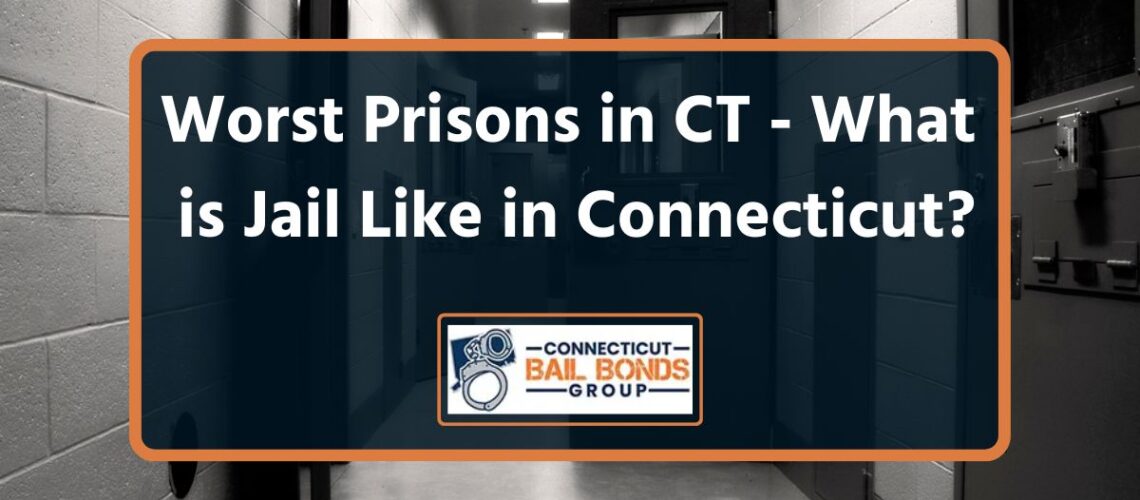The very first thing that anyone should know about Connecticut prisons is that you do not want to find yourself in one. If you do, a company that specializes in bail bonds in CT can help to get you out. You might think that there is no way such a thing could ever happen to you, even if you end up facing something relatively minor such as a DUI (driving under the influence) charge. After all, even if you get jail time for a DUI, it will be so little that you will serve that time in county jail, right? The problem here is that Connecticut differs from other states in that it has no county jails.
So even if you just get a 10-day sentence for a DUI or any other criminal offense in the state of Connecticut, you will see the inside of a prison. Connecticut has a total of 14 prisons, not counting federal prisons located in the state. The very first prison in Connecticut was the Old Newgate Prison in East Granby which has a very interesting back story that deserves more than one book being written about it. This prison was first built as a copper mine in 1705 when Connecticut was still a colony. Unfortunately, it failed to make much of a profit as a copper mine so the colony decided to use the mine’s tunnels as a prison! It’s hard to imagine the poor conditions that those prisoners had to endure. The Old Newgate Prison in East Granby was used to hold prisoners during the revolutionary war and became the state prison in 1790, 85 years after being built as a mine.
The Worst Prisons in Connecticut

Here is a list of some of the best known “worst” prisons in Connecticut as of 2023, along with unique explanations for each one. This list is based on available data and reported incidents. However, it’s important to note that the term “worst” is subjective and can be interpreted in different ways, depending on the specific metrics one might use to evaluate a prison’s conditions.
- Robison Correction Institute: This medium-security prison was originally built in 1985 and had a capacity of 1473 inmates. It was later rebuilt to upgrade security measures, reducing its capacity to 880 inmates. Issues include a lack of visitation rights for inmates, an inconsistent schedule, and cuts in the budget for inmate facilities to fund rehabilitation programs, leading to uncomfortable conditions and low medical facilities.
- York Correctional Institute: Initially opened in 1918 for both male and female inmates, it was closed and reopened in 1994 for women only. York Correctional Institution is in Niantic and is the state’s only prison that is fully dedicated to housing female inmates. It has a capacity of 1515 inmates. This prison was closed due to a long, five-day riot due to perceived inequality between inmates, resulting in 43 prisoners’ deaths and more than 50 staff/guards’ deaths.
- Hartford Correctional Institute: Opened in 1977, this facility houses both adult and juvenile prisoners. It offers separate programs for each group, including online courses for juveniles. A significant issue at this institute was a death of a juvenile prisoner in 2022 due to a lack of oxygen in their cell, an issue attributed to mismanagement.
- Corrigan-Rogowski Correction Institute: Opened in 1994, this institute was built to mitigate overcrowding in other prisons. It has a capacity of 1586 prisoners and has a level 3 medium security level. In December 2022, a guard was heavily injured by an inmate in a heated argument, and despite such incidents, no inmates were held accountable, leading to concerns about the safety of the staff.
- Osborn Correctional Institute: Also known as the Connecticut Correctional Institution, this facility was opened in 1963 with a capacity of 1900 inmates. While it offers rehabilitation facilities, there was an incident in which an inmate found dead due to mistreatment and lack of proper medical treatment.
- Cheshire Correctional Institute: Established in 1913, it had a capacity of 158 inmates. In 1994, a gang ignited a riot in the prison, leading to the death of two high-profile prisoners. While no staff members were killed, many were reportedly beaten. One of the most interesting things about the Cheshire Correctional Institution is that when it was built in 1910, inmates from Wethersfield State Prison were used to build part of it. Imagine helping to build a prison where you yourself might be confined one day; a dreadful prospect that a New Britain bail bondsman in Connecticut can get you out of. Click here for more: https://www.connecticut-bailbonds.com/
- MacDougall-Walker Correctional Institution: This is the largest and most populous prison in Connecticut, with a capacity of about 2050 prisoners. It facilitates all the adult and high-profile prisoners with a maximum of level 5 security measurements. An issue here was that a prisoner charged with multiple murders had his sentence reduced, raising concerns about the effectiveness of the prison’s punishment system.
What is Jail Like in Connecticut?

In Connecticut, the jail and prison system is under the purview of the Connecticut Department of Correction (DOC). Jails in Connecticut are typically used for short-term incarceration, usually for those awaiting trial or serving shorter sentences, while prisons house individuals serving longer sentences. The state’s correctional facilities vary widely, from minimum-security institutions to maximum-security prisons, each with its own unique conditions and challenges.
Facilities and Infrastructure

Connecticut correctional facilities range from older, historical buildings to newer, more modern structures. They are designed to house a diverse population of inmates, from minimum to maximum security prisoners. The capacity of these facilities can vary widely, from smaller jails housing a few hundred inmates to larger prisons accommodating over a thousand.
The physical conditions in these facilities can differ based on the age of the facility, its security level, and the population it serves. Some facilities may be cramped, with inmates housed in cells with one or more cellmates. Other facilities might have more open, dormitory-style housing. Facilities are generally equipped with recreational areas, dining halls, and medical facilities.
Daily Life

Inmate life in Connecticut jails and prisons is regimented, with strict schedules for meals, recreation, work assignments, and educational or rehabilitation programs. Inmates usually have the opportunity to engage in various activities like educational classes, vocational training, and substance abuse programs. These programs aim to help inmates acquire new skills, improve their behavior, and better prepare for life after release.
However, life in jail can also be tough. Overcrowding can sometimes be a problem, leading to tension among inmates and making it difficult to maintain optimal living conditions. Some inmates may have to cope with old and uncomfortable beds, limited medical facilities, and restrictions on visiting rights.
Challenges and Issues

In Connecticut, the jail and prison system is under the purview of the Connecticut Department of Correction (DOC). Jails in Connecticut are typically used for short-term incarceration, usually for those awaiting trial or serving shorter sentences, while prisons house individuals serving longer sentences. The state’s correctional facilities vary widely, from minimum-security institutions to maximum-security prisons, each with its own unique conditions and challenges.
11 Asylum St, Suite 512 Hartford, CT 06103
(860) 420-2245
Follow Us On Social Media


